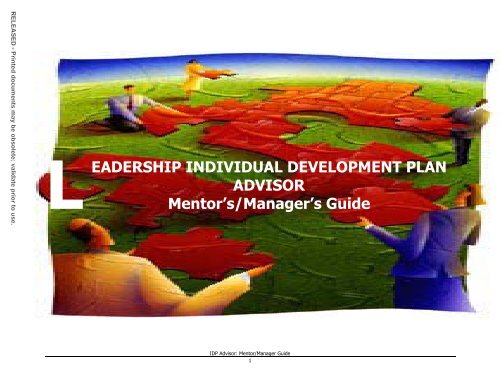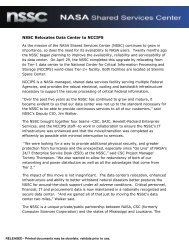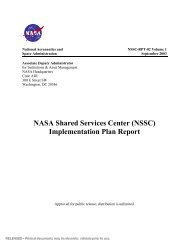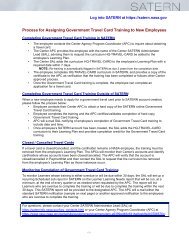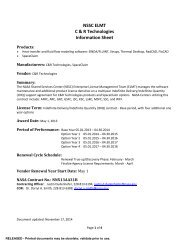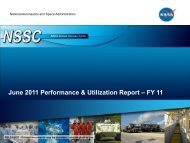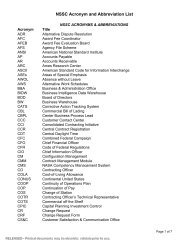1 - NSSC Public Search Engine - NASA
1 - NSSC Public Search Engine - NASA
1 - NSSC Public Search Engine - NASA
- No tags were found...
Create successful ePaper yourself
Turn your PDF publications into a flip-book with our unique Google optimized e-Paper software.
LEADERSHIP INDIVIDUAL DEVELOPMENT PLANADVISORMentor’s/Manager’s GuideIDP Advisor: Mentor/Manager Guide1RELEASED - Printed documents may be obsolete; validate prior to use.
RELEASED - Printed documents may be obsolete; validate prior to use.PURPOSEThis document lays out guidelines and suggestions for mentors and managers about how to construct an IndividualDevelopment Plan for individuals interested in careers in management. The activities and concerns for mentors and managers in thedevelopment process have parallels. The mentor provides an objective and outside perspective on development while theemployee’s manager offers more formal career development coaching. Both perspectives are valuable and work together to create ameaningful development process.This guide uses the <strong>NASA</strong> Leadership Model as a framework. First, the Advisor provides a framework for mentoring and coaching foremployee development as a process including suggested roles and responsibilities, suggested processes and challenges. Second,the Advisor presents suggestions that mentors and managers can use to help protégés/employees make career choices, particularlychoices that lead to a career in technical or professional management. Third, it overviews the <strong>NASA</strong> Leadership Model, itsconstruction and elements. Next it offers suggestions for how to use the Leadership Model to craft an Individual Development Plan(IDP) for the individual being developed. Finally it provides a list of resources that can be useful in designing and executingdevelopment activities.Creating an IDP might be undertaken for a number of reasons including applying for, or participation in, the Personal DevelopmentProcess (PDP) or the Senior Executive Candidate Development Program (SESCDP), during the application process for a FellowshipProgram or for purposes of overall development. In any case, constructing an IDP is part of an overall development strategy thatshould not be undertaken alone. Your protégé/employee should be working with yourself, center management and, theirmanager/mentor to complete the IDP and resultant development activities. The more the individual works together with theirmentor and with their management the more rewarding the experience will be for the protégé and for <strong>NASA</strong>.The Advisor is intended to supplement other career planning tools and methodologies offered by the Agency, your Center orEnterprise. There are many useful tools that have been created that help guide careers at <strong>NASA</strong> and this Advisor is only one ofthem. For example, the Program and Project Management Development Process (PMDP) offers a wide variety of advise aboutIDP Advisor: Mentor/Manager Guide2
RELEASED - Printed documents may be obsolete; validate prior to use.careers in program and project management, while the Chief Financial Officer (CFO) provides a development model for thoseindividuals with careers in the finance organization. The Leadership Model is meant to provide guidance on the competence areas,knowledge, skill and experience needed for ALL leadership roles in <strong>NASA</strong>. Other career models are critical to supplementing theLeadership Model by providing specific advice and council on the competence areas and development actions necessary at thefunctional level. The last section of this document provides a set of contacts for other career development models at <strong>NASA</strong>.Throughout this document we will make reference to these other documents, self-assessments, career models, programdescriptions, etc. We provide a set of hot links to these sources so the user can just click to the actual source.IDP Advisor: Mentor/Manager Guide3
RELEASED - Printed documents may be obsolete; validate prior to use.Your Role as Career Coach or MentorYou play an important role in your employee/protégé’s development and in the creation of their IDP. At all points in theprocess it is critical that the employee/protégé involve their manager and/or mentor to ensure that development activities arerealistic, targeted, and supported by the appropriate resources and management attention. The roles of the person beingdeveloped, manager, mentor and the Installation’s training office in development are described below:Employee/protégé: The employee/protégé takes primary responsibility for their own development. This includes completing theirIDP, researching development assignments and development programs, workshops and education. They should take accountabilityfor scheduling time with their manager and mentor to review plans and activities and to seek out advice and counsel from others.They should also take responsibility for leveraging their development experience into performance and results.Mentor: The mentor is outside the chain-of-command and acts as sponsor, teacher, counselor, door opener, etc. The mentor is aconfidant who provides perspective, helps the employee/protégé reflect on the experience the protégé is developing, and providesopen, candid feedback. The mentor plays an advisory, not an evaluative role, and therefore has a unique opportunity to serve as a“sounding board” on issues and challenges they may not share with individuals within their own organization. The mentor helpsformulate the IDP and reflect on what the protégé is learning along the way. They are also often helpful in negotiating thedevelopmental assignments.Manager: The manager should act as the person’s primary career and development coach; discussing strengths and areas forimprovement, planning development assignments and attendance at workshops and ensuring the person is reaching their fullpotential. Also, often the employee will continue in their regular jobs while completing rotations or other developmental activities.As a result, the manager plays a vital role in planning development activities and work assignments so that both are optimized.There are times when the manager must assist in prioritizing existing work assignments so that time is available for development.The manager’s primary role is to coach the person about development options, strengths and areas for improvement, jobresponsibilities and linking newly developed skills into current assignments.Installation and Agency Level Training Offices: The Installation and Agency Training Offices are key resource. They provideinformation on a wide range of development opportunities and can help match opportunities to developmental needs. TrainingOffice personnel can also provide support when problems emerge in the development and mentoring processes.IDP Advisor: Mentor/Manager Guide4
RELEASED - Printed documents may be obsolete; validate prior to use.The Specific Role of the Mentor/Manager in DevelopmentThe mentor plays a valuable role in the development process by serving as a “touch stone” and objective advisor. Protégé’s oftenneed someone to talk with as they face the challenges of performing new duties and learning new skills. The mentor can beinvaluable in helping the person structure their Individual Development Plan. Sometimes the mentor also gets involved in helpingthe protégé negotiate their developmental work assignments. Unlike managers, mentors do not have the role of judging theperformance of the protégé. Therefore, they are free to provide advice and counsel without appearing to be critical. Protégé’s canchoose not to follow mentor’s advice without fear of repercussions.The manager serves as a more formal career coach. They are accountable for planning and holding formal career discussions withall employees, helping employees to create meaningful IDPs that fulfill career objectives and assisting in obtaining the appropriatelevel of education, training and on-the-job experience necessary to reach their potential. Managers also have a responsibility toprovide honest feedback about capabilities and performance so that employees can make informed career and developmentdecisions. They, on the other hand, need to also serve as a career coach and facilitator and allow for time and resources forexploration and discovery in career development.Learning new things can be overwhelming and confusing. The mentor and their manager can help the person step back and reflecton what they are learning. Mentors/managers draw on their own experience to suggest alternative approaches to challengingsituations; they can help break old habits and develop new tools. Mentors and managers also serve as powerful role models. Theemployee/protégé not only relies on the mentor for advice, but also watches the mentor in action. Many people report that theyshadow their mentors during meetings and day-to-day operations and learn about management style from observing their managerin their day-to-day work.Employees get the most out of their development experience when mentors and manager coordinate their activities, feedback anddevelopment plans.What Mentors/Managers Get Out of the Development ProcessThe mentoring or coaching relationship can also benefit the mentor/manager. The most consistent feedback frommentors/managers is that they gained personal satisfaction from watching their employee/protégé grow during the course of thedevelopment program. Many informal mentors even report that the mentoring relationship continued well beyond the end of theIDP Advisor: Mentor/Manager Guide5
RELEASED - Printed documents may be obsolete; validate prior to use.formal program activities. To the surprise of many mentors and managers, involvement in mentoring and employee developmentactivities provided them with development as well. Many find that their employees' or protégé’s questions cause them to think aboutthings in new ways and really examine their own actions and habits. Mentors and managers can learn vicariously through theexperiences and reflections of their employees and protégé’s.What it takes to be an Effective Mentor and Career CoachEffective mentoring and career development coaching comes from a combination of experience, commitment, and skill. The mostvalued mentors and development coaches have a wealth of experience and are willing to share stories of their successes and theirfailures. Commitment to the development of the employee or protégé is also essential. The effective mentor and career coachviews the relationship as an opportunity to help develop the person’s ability to think critically and make decisions, not just to developspecific leadership skills. Mentors and managers alike must commit their time to the relationship; making themselves accessible andspending the time necessary for the person being developed to really reflect on what they are learning. Often protégés and theirmentors spend informal time together so that they separate themselves from the pressures on the work environment.Finally, effective mentoring and career coaching requires some skills. Some feel they have these skills upon entering therelationship. Many more report that they develop these skills, skills that are valuable to them throughout their mentoring orcoaching experience, more fully as a product of the relationship. Effective mentors and coaches have and through their experiencecontinue to develop their skills in:Listeninglistening (and observing body language) for deep meaningQuestioningGiving FeedbackResolving DifficultIssuesusing open-ended questions to stimulate others to reflect ontheir experiences and think in new wayshelping others reflect on the nature and implications of theirbehavior and actions without being overly criticalopenly discussing and resolving relationship and other sensitiveproblemsIDP Advisor: Mentor/Manager Guide6
Later in this document we suggest a step-by-step process for meetings with employees/protégés as well as suggestions for makingmentoring and career coaching more effective.IDP Advisor: Mentor/Manager Guide7RELEASED - Printed documents may be obsolete; validate prior to use.
RELEASED - Printed documents may be obsolete; validate prior to use.Leadership as a CareerThe protégés/employees career interests are important to consider prior to completing their IDP and planning developmentactivities such as training, education or rotations. Today, there are many choices for careers that include becoming a technical orprofessional expert in your field, seeking variety in your work such as consulting or leading different types of projects in addition to acareer in leadership or management. Horizontal, spiral, as well as upward growth are accepted paths for careers here at <strong>NASA</strong> andin other organizations. Indeed, prior to completing an IDP that focuses heavily in the leadership or management arena, everyoneneeds to take time to consider the following questions:Are they currently managing or leading others? In what capacity—technical leadership or purely managerial responsibilities?If they have experience leading or managing others, did they enjoy the experience and responsibility?Would they “give up” more technical responsibilities in order to focus on managing others?Do they enjoy mentoring and coaching others or are they more interested in solving technical problems?Do they enjoy the politics associated with managing and leading?If your protégé/employee answered “no” to one or more of these questions you might wantto have them consider focusing their career development activities on more technical orprofessional areas rather than in management…or you might want to suggest“trying out” a management position to see how it feels. Your protégé or employee might want tovolunteer to be a team, project or task leader on a future assignment as wellas take a Center-level leadership program to learn about leadership.As a mentor or manager you also might want to have the person shadow you in yourmanagement roles and discuss whether your everyday activities are of interestto them in the long run.IDP Advisor: Mentor/Manager Guide8
RELEASED - Printed documents may be obsolete; validate prior to use.Leadership Model OverviewThe Leadership Model is a powerful tool for development activities. It provides a framework for you to use in providingdevelopmental advice and counsel. The Leadership Model was created to help ensure that leadership and managementdevelopment at <strong>NASA</strong> is aligned to the requirements of the <strong>NASA</strong> Strategic Plan and Strategic Management System. The LeadershipModel was also designed to ensure that the learning strategy for leadership and management development is integrated across theAgency and that there is a broadening of learning modalities that go beyond traditional classroom techniques that include learningfrom experience, peers and managers.The Model was created and validated with input from over 550 <strong>NASA</strong> leaders at all levels and across all Installations. Outsidesources from academia and industry also provided useful input to ensure the Model was forward looking and competitive with thedemands of the external environment. The Leadership Model integrates efforts to define leadership competencies at the functionallevel including the Program and Project Management Initiative, CFO Initiative, <strong>Engine</strong>ering Initiative and others.The Model is currently being used as the basis for the <strong>NASA</strong> Leadership 540-degreee feedback process used in the ManagementEducation Program (MEP), the Managing the Influence Process (MIP) and in the Senior Executive Career Development Process(SESCDP). The 540-degree feedback process based on the Leadership Model is also a prerequisite for participation in the <strong>NASA</strong>Fellowship Program in 2001. The Model is provides guidance about the design and development of new education program such asthe Business Education Program, the Executive Business Education Program and the Global Leadership Program.The Model addresses four leadership levels that are applicable across the Agency:• Executive Leaders at Headquarters and Center Directors at each Installation,• Senior Leaders at each Installations who report to Center Directors,• Managers or Leaders of Others (managers or supervisors of others who have formal accountability for performance reviews andmanagement), and• Influence Leaders such as Team Leaders or Project Managers who have informal authority over work teams to accomplish tasks,projects or special assignments.IDP Advisor: Mentor/Manager Guide9
RELEASED - Printed documents may be obsolete; validate prior to use.Leadership Model Performance Dimensions and Competence AreasThe Cornerstone of the Leadership Model is a set of Performance Dimensions. Performance Dimensions are families of competenceareas that represent measurable skills, knowledge or personal characteristics that can be demonstrated to deliver higherperformance. They form the platform for how the Model aids in assessment, development and coaching applications. They providethe backbone of the information that you and your employee/protégé will need to construct their Individual Development Plan.Six performance dimensions were defined from this study for the <strong>NASA</strong> Leadership population. Complete results of eachPerformance Dimension and a full description of its competence areas for each level of leader are found in the final report availablefrom Jan Moore in Code Ft (202-358-2184) or can be found on the web at www.hq.nasa.gov/office/codeef/codeft/. An overview isprovided below:1. Personal Effectiveness (managing self as leader including taking accountability for personal development and possessingattitudes, characteristics and other qualities important in leadership roles).2. Discipline Competency (maintaining an appropriate level of expertise in the discipline that is being managed).3. Business Acumen (understanding and application of the <strong>NASA</strong> strategy, implementation activities and fiscal and businessmanagement process that impact and are relevant to <strong>NASA</strong>).4. Working Internationally (understanding, knowledge and skill in being an effective international partner).5. Managing Information and Knowledge (understanding, knowledge and skill in effectively creating, managing and sharingknowledge and leveraging it into organizational learning).6. Leading and Managing Others (possessing knowledge and skill in leading change, managing teams and individuals andmanaging work).A picture of the Leadership Model including all six Performance and their Competence Areas are shown on the next page.IDP Advisor: Mentor/Manager Guide10
RELEASED - Printed documents may be obsolete; validate prior to use.CompetenceAreasPerformanceDimensions<strong>NASA</strong> Leadership ModelPERSONAL EFFECTIVNESSCognitive SkillsRelating to OthersPersonal Capabilities and CharacteristicsDISCIPLINE COMPETENCY MANAGING INFORMATIONAND KNOWLEDGEBroad Understanding of Discipline Use of Information TechnologyMaintain Credibility of Discipline Knowledge ManagementCommunication/AdvocacyLEADING AND MANAGING WORKING INTERNATIONALLYOTHERSLeading and Managing Change International PolicyLeading and Managing People Cross-Cultural RelationshipsLeading and Managing the Work International Partnerships/AlliancesBUSINESS ACUMENInternal/External AwarenessOrganizational CultureOrganizational StrategyBusiness DevelopmentBusiness ManagementCustomer/Stakeholder/Partner RelationshipsIDP Advisor: Mentor/Manager Guide11
RELEASED - Printed documents may be obsolete; validate prior to use.Creating the IDPA general overview and set of guidelines for creating an IDP can be found on the web at www.XXXX. In addition, the IDPform template can be found on the web at www……… Please review both sets of guidelines prior to using this section of the Advisor.The focus here is on using the Leadership Model to construct a meaningful development plan.There are five major steps to using the Leadership Model to help create an IDP. The steps correspond to completing the IDPprocess. Your role as a manager/mentor is to help your employee/protégé move through the process in a thoughtful andmeaningful manner.Step One: Determine your Employees/Protégé’s Long-Range (five or more years) Career Objective (place thisobjective in Section 1A of the IDP Form)Again be certain that the person is really interested in leading and managing others as a formal career option. Consider whetherthey are willing to back off of their technical or professional responsibilities in order to focus more on leading, planning, coaching,mentoring, and counseling others in their work. The reality is that most of us do have to opportunity to lead others without formallymoving into a managerial role, often as a team leader or a project manager. The decision to move from a technical to managerialcareer path should not be taken lightly. We recommend that if they do not have management experience, that you suggest thatthey “try out” a leadership role by volunteering for a project or as a team lead before making a leadership career a formal objective.Talking with their mentor and with their manager and others in various managerial roles is another good way to assess whetherleadership is a good option for them.If your employee/protégé is currently serving in a management or leadership role, their long-term career objective might be tobecome more proficient at their current role or move into a higher-level role in the future. If this is the case, then use the followingdescriptions of various leadership roles to help them determine their long-term objectives (You may want to tailor the description tothe Center’s terminology):• Executive Leader which include Administrators and Associate Administrators at Headquarters and Center Directors at eachInstallation,IDP Advisor: Mentor/Manager Guide12
RELEASED - Printed documents may be obsolete; validate prior to use.• Senior Leaders at each Installations who report to Center Directors such as Directors of,• Managers or Leaders of Others (managers or supervisors of others who have formal accountability for performance reviews andmanagement), and• Influence Leaders such as Team Leaders or Project Managers who have informal authority over work teams to accomplish tasks,projects or special assignments.It is important that everyone is clear about which level of leadership is a long-term target, as this will determine how they use theLeadership Model to craft their IDP. Also, if you are a mentor, be certain that the protégé’s manager agrees with their target andaligns their recommendation for a target role with your own (this corresponds to the first part of Section 1B of the IDP form).Step Two: Read About and Validate Your Employee’s/Protégé’s Long-Term ObjectiveNext, we recommend that you and your employee/protégé validate their long-term career choice by reading about it in theLeadership Model itself. You can visit the web site for the Leadership Model at www.hq.nasa.gov/office/codeef/codeft/ and click onthe <strong>NASA</strong> Leadership Model. Read about the Model itself and how it is constructed and then go to the level that was targeted for along-term career objective: Executive Leader, Senior Leader, Manager/Supervisor or Influence Leader. Review the information in thedescription of each of the Performance Dimensions for the target level and then determine if this level is what you and youremployee/protégé intended. If not, move up or down a level until you feel comfortable that you have selected the target level thatsuits their career objectives. Remember this information and resulting decisions should always be discussed with the person’smanager, even if a mentor is involved.Step Three: Help Your Employee/Protégé Create Long-Term Development Objectives (Section 1A of the IDP Form)From the examination of the Leadership Model, create three to five development objectives that support the long-term careerobjective. A development objective to move into the role of supervisor/manager, for example, might be to gain experience inmanaging others in a variety of different types of situations; simple and routine as well as complex and complicated. A developmentobjective to move into the role of senior leader might be to become effective at leading people who lead others or to becomeproficient in creating management processes that span Center boundaries or to be able to lead large scale organizational changeactivities.Clearly long-term development objectives need to match the level of the target role and the needs of the environment. You andyour employee/protégé can use the information in the Performance Dimension and Competence Areas of the Leadership Model toIDP Advisor: Mentor/Manager Guide13
RELEASED - Printed documents may be obsolete; validate prior to use.guide this process. For the target level, read the descriptions of each Performance Dimension and the Competence Areas under it.Discuss which Performance Dimensions and Competence Areas are going to be most critical for success in the target role. Thesemight be the areas that the person has targeted for their long-term development objectives. Of course, you are free to add otherlong-term development objectives that are associated with your Center’s strategy or other business demands.Step Four: Assess Your Employee/Protégé’s Current Capabilities Against Long-Term Objectives (Corresponds toSections 1A, 1B and IC)Once you and your employee/protégé have selected a target role and set of development objectives, have them self- assess and/orhave others provide feedback on their perceptions of performance in each target competence area. There are two sets ofassessments based on the Leadership Model that can be used by the person being developed, their manager and their mentor tohelp complete Sections 1A, 1B (manager assessment) and 1C (mentor assessment). The first is to complete a 540-degree feedbackprocess based on the Leadership Model.540-degree feedback takes input from the following individuals on their perceptions of performance again the Competence Areas inthe Leadership Model:self,manager,direct reports,customers,suppliers, andmentors/coachesand provides you confidential feedback about how each of these parties’ view employee/protégé ‘s behavior in each element of theLeadership Model. These perspectives can then be compared to build a profile of strengths and areas for improvement that can beused in development planning and in completing the IDP.The 540-degree feedback tool is web as well as paper and pencil based. An external company, CSI administers the assessment toensure confidentiality in the rating and feedback process. The tool and the feedback reports never reside in a <strong>NASA</strong> database or ona <strong>NASA</strong> server. CSI provides feedback from the 540-degree process in small group settings with similar levels of managers soparticipants can ask questions and plan development actions. One on one consultation is also available for those who are interested.IDP Advisor: Mentor/Manager Guide14
RELEASED - Printed documents may be obsolete; validate prior to use.Potential development actions will be reviewed in small group or individual settings including training, on the job assignments,rotations, etc. Participants select those development actions that specifically address their feedback. It is recommended that everyperson discuss their feedback with their manager and/or mentor. This is especially helpful in completing the IDP.If your employee/protégé is interested in the 540-degree assessment contact Jan Moore at 202 258 2184 or email her atjan.moore@hq.nasa.gov.A second option is to complete the web based self-assessment that is located on the <strong>NASA</strong> Leadership Model web site. Theemployee/protégé should select the assessment that fits their target leadership objective and complete it. They may print out theresults and review them with their mentor/or manager. The results should be helpful in completing Sections 1A, B and C of the IDPform.It is important to help your employee/protégé interpret the results of their assessment and translate them into action. Discussinglearnings from the assessment and implications for development is a critical part of the manager and the mentor’s role.Step Five: Create Development Actions that Match Your Employee/Protégé’s Objectives and the Results of theirAssessment (Section II of the IDP form)The final step in creating an IDP is to craft development actions that match long-term objectives and the results of the self or 540-degree feedback assessments. A broad range of development opportunities that combine formal training or workshops with on thejob experience are most appropriate. The best development plans combine formal training and education with experiential activitiessuch as rotations, on-the-job assignments, task forces and special projects. Also, don’t forget to consider a Fellowship Program orthe <strong>NASA</strong> Personal Development Program for formal education or rotation experiences.There are a number of resources available that can help craft development actions for an IDP. The <strong>NASA</strong> Leadership web site offersa full database of development options including training, education and on the job experiences that are matched to the results ofthe self- assessment or the 540-degree feedback process. Visit the <strong>NASA</strong> Leadership Model web site atwww.hq.nasa.gov/office/codeef/codeft/ (Joe how will this work).Your Center’s Training Office is also a good source of information about rotations, special assignments, Fellowship opportunities andformal development programs.IDP Advisor: Mentor/Manager Guide15
RELEASED - Printed documents may be obsolete; validate prior to use.Your role as a manager and mentor will also be to suggest development activities, discuss the reality of development options, helpmake contacts that can facilitate development assignments as well as provide a valuable sounding board for how developmentassignments and educational program can be leveraged into performance and action.Step Six: Monitor Progress and Make Adjustments (Section III of the IDP form)We recommend that the person being developed meet with their manager and mentor at least once every six months to monitorprogress and to make adjustments to the development plan as necessary. Circumstances change, new opportunities arise and theyshould be ready to capitalize on them to achieve your development needs. In addition, it is a good idea, once every 12-18 monthsto retake the self-assessment or the 540-degree feedback assessment and adjust development plan based on the results.The following section provides general guidance about planning and executing these meetings update meetings.IDP Advisor: Mentor/Manager Guide16
RELEASED - Printed documents may be obsolete; validate prior to use.Mentoring and Coaching Meetings and GuidelinesThe following are a set of guidelines that can be used to make your mentoring or coaching experience more valuable foryou and for your protégé/employee.MentorsProtégé’s can talk with their mentors about anything. However, early in process some mentor/ protégé pairs have troublegenerating conversation. In general, the protégé should direct the conversation during mentoring sessions by coming prepared withitems to discuss. Early in the process discussion generally focuses on the creation of the Individual Development Plan. Protégésalso report spending their first meetings just getting to know their mentor by having them share stories about their career,experiences, and development. As the process progresses, most want to talk with their mentor about the experiences they arehaving and challenges they are facing.Some protégés schedule regular discussion appointments with their mentors (i.e. once every two weeks, once a month). Othersschedule meetings with their mentors to coincide with major events in their IDP. Regardless of the arrangement, the protégé andthe mentor should work together to schedule mentoring sessions and ensure that the conversations focus on the issues meaningfulto the protégé.Mentors and ManagersThere are specific times during the process when it is highly recommended that the employee or protégé and the mentor ormanager talk. Suggested in below is a set of events around which discussion is recommended. Protégés or employee and theirmentors or managers can use these suggestions to anticipate how they might want to spend their time together.IDP Advisor: Mentor/Manager Guide17
RELEASED - Printed documents may be obsolete; validate prior to use.Suggested MeetingsInitial Meeting(s) – Share expectationsand create preliminary IDPMeeting after Development of the IDPMeetings for Development AssignmentsDiscussions about Seminar AttendancePotential Discussion TopicsTime in this initial meeting should be spent with the employee/protégé :• Getting to know one another and discussing career interests, values and goals• Sharing their expectations (hopes and concerns) for the mentoring or coaching relationship• Planning to obtain assessment or feedback data (if necessary)• Formulating the content of the preliminary Individual Development Plan (IDP)• Creating a preliminary schedule to complete the IDP processAfter the completion of the IDP their should be discussion of:• The reality of the IDP• Results of assessments (including 540-degree feedback)• Development opportunities and linkage to career goals• The schedule for development activities• Revisions to the IDPThe mentor/manager and protégé/employee should talk:1. Before each developmental assignment to answer the following questions: What experiences does theperson need to have? What skills should they focus on developing?2. Mid-way through each assignment (at least) to answer the following questions: How is the assignmentgoing? Are the skill development experiences materializing? What challenges are being faced and howmight they be dealt with? What support can the manager/mentor be providing?3. After each assignment to discuss learning and implementation and sharing of those learnings.The mentor/manager and the protégé/employee should talk:1. Before each seminar or educational experience to review the seminar content and answer: How should thisseminar help the person accomplish their goals?2. After each seminar to share learnings and to define on-the-job opportunities for the person to practice thenew skills/use the new knowledge.Ongoing • To update and plan new development activities.• To review the success of overall development.• To discuss career options and career mobility• To complete and close out the IDPIDP Advisor: Mentor/Manager Guide18
RELEASED - Printed documents may be obsolete; validate prior to use.ResourcesThe following are resources available at the Agency level that might prove helpful in development and constructing the IDP.Resource Description How to AccessIndividual Development Plan(IDP) templateTemplate for completing the IDP form<strong>NASA</strong> Leadership Model web site Model description, Performance Dimensions and Components www.hq.nasa.gov/office/codeef/codeft/<strong>NASA</strong> Leadership Model hardcopy<strong>NASA</strong> Leadership Model selfassessmentModel description, Performance Dimensions and Componentsin hard copySelf assessment based on <strong>NASA</strong> Leadership ModelCindy Gaurino at RGI: 703www.hq.nasa.gov/office/codeef/codeft/Leadership Model 540-degreefeedback processDevelopment options based on<strong>NASA</strong> Leadership ModelProgram and ProjectManagement DevelopmentProcessChief Financial Officer CareerDevelopment Process540-degree feedback process based on the Leadership ModelDatabase of development actions including training,education and rotational options based on the LeadershipModelDescription of project and project management careerdevelopment processDescription of Chief Financial Officer management careerdevelopment processJan Moore: 202 358 2184 orjan.moore@hq.nasa.govwww.hq.nasa.gov/office/codeef/codeft/Edward Hoffman: 202 358 2182Gail Williams at 301 286IDP Advisor: Mentor/Manager Guide19
RELEASED - Printed documents may be obsolete; validate prior to use.<strong>Engine</strong>ering Career DevelopmentModelAdministrative CareerDevelopment modelFellowship ProcessPersonal Development Program(PDP)Senior Executive CareerDevelopment Process (SESCDP)Description of engineering management career developmentprocessDescription of Administrative career development processInformation on the Agency level Fellowship applicationprocessPat Patterson at 202 358-Chris Williams at 202 358 2146Information on the PDP application process Chris Williams at 202 358 2146Information on the SESCDP application process Jan Moore at 202 358 2184;jan.moore@hq.nasa.govIDP Advisor: Mentor/Manager Guide20
RELEASED - Printed documents may be obsolete; validate prior to use.Mentor/Coaching Advice: Appendix AThe following are suggestions to make the mentoring/coaching process more viable.Problem Likely Cause Strategy Potential SolutionDependency – Protégé/employeebecomes too dependent onmentor/manager for advice andbecomes hesitant to makedecisions without “approval”Protégé Experiences MentorRelationship as Evaluative vs.Developmental – Protégéperceives mentor as a judge whocan negatively impact his/hercareer instead of as a careeradvisorProtégé/employee inflates thestatus of the mentor/manager.Mentor/manager overly critical ofprotégé/employee decisions earlyin relationship instead ofchallenging to explore theimplications of their decisions.Too eager to “help” (answersquestions/takes actions tooquickly)Protégé responds to feedback andadvice as criticism.Mentor offers advice and feedbackin a way that feels critical.Discussions focus only onnegatives and ignore positiveprogress.Establish relationship as apartnership of individuals learningfrom each other.Protégé/employee: takes adviceas input, avoid “checking” withmentor too frequently.Mentor/manager: ask questionsand encourage independentthought – offer advice sparingly.Balance discussions between whatis going well and improvementopportunities.Protégé: work on taking feedbackand advice as developmentalassistance not criticism; avoiddefensive reaction and developactive listening skills.Clarify roles of manager/mentorOpenly discuss perceptions ofdependency (mentor/manager willprobably notice it first). Committo new ways of working together.Openly discuss perceptions ofevaluative climate (protégé willprobably notice it first). Committo new ways of working together.Take a seminar together on givingand receiving feedback.Invite a facilitator to sit in on afew of your meetings and give yousuggestions.IDP Advisor: Mentor/Manager Guide21
RELEASED - Printed documents may be obsolete; validate prior to use.Problem Likely Cause Strategy Potential SolutionTension between Protégé,Mentor, and Manager –sometimes protégés feel caughtbetween the expectations andadvice of their manager and thatof the mentor. Issues of loyaltyand power can develop.Lack of Trust – person,mentor/manager or both lack thetrust in the other to make therelationship productive. Sometimetrust centers on the degree towhich each party feels the other iscommitted to the intent of theprocess.The mentor and manager havevastly different styles, experience,etc. (this can be an advantage toa protégé who can learn fromboth).The supervisor does notunderstand or support thementoring relationship.The protégé (knowingly orunknowingly) pits the mentor andthe supervisor against each other.Lack of clearly stated expectationsfor the relationship.Lack of follow-through oncommitments made to oneanother.Inappropriate use of informationshared in career conversations.Mentor and manager should shareexpectations for the mentoringrelationship (these expectationsshould be formulated in the initialmentoring meeting).Mentor, supervisor, protégéopenly discuss how the three-wayrelationship can be of most benefitto all.Develop a clear list of agreedupon expectations and groundrules during initial meeting.Revisit list periodically to check onhealth of the relationship.Open three-way conversation ofdeveloping concerns andagreement on new ways ofworking.Openly discuss the sources ofmistrust and agree on new waysof operating.IDP Advisor: Mentor/Manager Guide22
RELEASED - Printed documents may be obsolete; validate prior to use.Problem Likely Cause Strategy Potential SolutionJealousy from Others – coworkersor others become jealousof the protégé’s/employee’sinvolvement and opportunities fornew experiencesDisappointment with Progress– one or both parties aredisappointed with thedevelopment progressInsecurity.Co-worker perception that theywill be asked to work harder to“cover” for person duringabsences.Perception that selection processwas somehow unfair.Mentor/manager does notperceive change in behavior ordevelopmentPerson not willing to change.Let others know about programinvolvement as necessary – to notover publicize involvement.Ensure that manager is makingadequate efforts to compensatefor absence.Discuss how change will begauged throughout program andspecifically as a result of eachmajor experience(assignment/seminar).Generally this problem is best leftalone unless it threatens the longtermworking relationship. Theperson may wish to talk with theother person if the relationship isthreatened. An empatheticmanager can also interveneeffectively.Openly discuss developmentalprogress. Commit to new ways ofworking if necessary.Experiences included in IDP arenot providing adequatedevelopment opportunities (theexperiences themselves may beinadequate or the person may becompleting them more asrequirements than developmentexperiences).Share observations ofdevelopment occurring/notoccurring. Collect feedback fromothers as helpful.Protégé/employee: be open toexperimenting with newbehaviors, take risks to use newapproaches. Discuss results withmentor.IDP Advisor: Mentor/Manager Guide23
RELEASED - Printed documents may be obsolete; validate prior to use.Problem Likely Cause Strategy Potential SolutionProtégé/Mentor Mismatch –despite attempts to solveproblems in the mentoringrelationship a very smallpercentage of protégé/mentorpairs continue to feel theirrelationship is not productiveLack of chemistry between theparties.Lack of trust cannot be overcome.Conflicting expectations for therelationship.Lack of investment on the part ofone or both parties.Consider initial mentoring match.Challenge match (if assigned)when history or circumstancessuggest the relationship will notbe productive.Develop a clear list of agreedupon expectations and groundrules during initial mentoringmeeting. Revisit list periodically tocheck on health of mentoringrelationship.Protégé: expand relationships toinclude additional “informal”mentors in development process.IDP Advisor: Mentor/Manager Guide24


